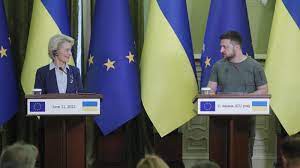The European Union’s executive branch suggested on Friday that Ukraine be granted candidate status, allowing it to join the 27-nation bloc in the future.
For a nation at war, the promise of participation in a union formed to keep the continent at peace is deeply symbolic. However, this is simply the first stage in what could be a decades-long process.
It didn’t stop the guns and artillery from killing civilians, leveling cities, and forcing millions of people to flee their homes since Russia launched its invasion of its neighbor on February 24.
Russia intensified its attacks on cities in Ukraine’s eastern Donbas area, leaving terrified people unsure of what the coming years will bring.
“We’re elderly, and we don’t have anywhere to go.” “What am I going to do?” Vira Miedientseva, an old resident of Lysychansk, which is just across the river from Sievierodonesk, a crucial focus of fights in recent weeks that Russians have nearly conquered, was one of the elderly locals struggling with the repercussions of a Thursday onslaught.
The European Commission’s decision is the first step on the lengthy path to membership, and it comes just one day after four European Union leaders pledged their support for Kyiv’s bid. The 27-nation bloc’s leaders will examine the idea at a summit next week in Brussels. All member countries must agree unanimously to begin accession talks.
The battle has raised pressure on EU nations to grant Ukraine candidate status sooner rather than later. However, the process is likely to take years, and EU states are split on how swiftly and fully to welcome new members.
Other recent advances include:
— On Friday, the Ukrainian navy claimed it had hit a Russian boat transporting air defense systems to a crucial Black Sea island. The navy stated the Vasily Bekh was used to deliver ammunition, guns, and troops to Snake Island, which is critical for protecting sea lines out of the major port of Odesa, in a statement posted on social media. It did not specify how much damage the strike caused.
Snake Island, 35 kilometers (20 miles) off the coast, made headlines early in the conflict when Ukrainian border guards stationed there resisted Russian demands to surrender; using colorful rhetoric that subsequently became a rallying cry. The Russian authorities did not respond to the Ukrainian claim right away.

















